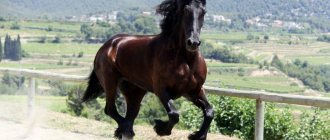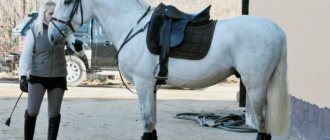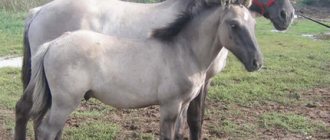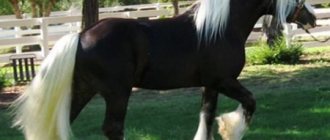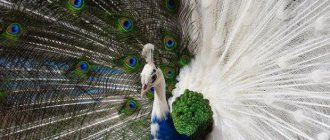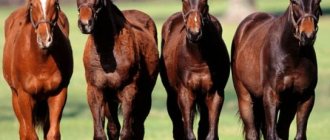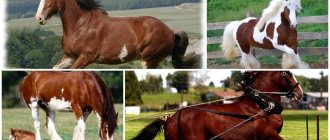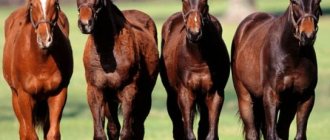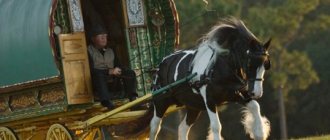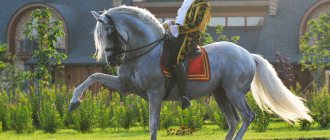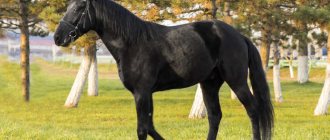Basic horse colors
Roan is any color, but with an abundance of white hair on the body. The least white hair is usually on the head and lower legs.
Not everyone knows this color of horses, although it can be seen quite often. What color can be considered roan? Foals are already roan from birth. Along their bodies, the background of the main color is mixed with white hairs. As the foal matures, the roan color remains.
The head, as well as the limbs of roan horses of this color, are always painted in a tone that characterizes the main color. The name of the suit is made up of the name of the suit that is the base suit and the adjective “roan”.
In roan horses, white hairs can be observed in the groin area or at the base of the tail. Horses have white hairs growing all over their bodies; they mix evenly with the hairs of the main color. What is the difference between roan horses and gray horses? A roan horse does not change color from birth until death. There is another very interesting feature.
If a roan horse damages the skin, then after healing, hairs of the color that was considered the main color of the horse grow in this place, mixed with white hairs.
On healed wounds of horses that have a different color, only white hair always appears. Roan horses exhibit early gray hair. This happens if the main suit is gray. If the roan color of horses appears in a piebald horse or in a forelock horse, then it becomes not very noticeable.
Roan color gene
A gene called Rn, which is always dominant, is considered responsible for this coloration in horses. For the birth of a foal that would have a roan color, it is necessary that its parent be a carrier of this genotype and be roan. American scientists believe that the combination of the same type of genes in both parents is associated with mortality. Foals from such parents die in the embryonic stage. At the present time, this theory has opponents and supporters.
However, there is information: there are fewer horse breeds where the roan color is found than breeds in which the background colors dominate. When breeding, for example, horses of the Shire breed, stallions of roan color, whose heads are “decorated” with an admixture of white hair, are discarded. For mares of this breed, white hair on their faces is not considered a fault. Roan horses often darken over the years.
Appearance
The horse's head is elongated, dry, with large lively eyes, wide nostrils and large or medium-sized pointed and mobile ears. Mental abilities are well developed. Of the senses, hearing is the best developed, while vision and smell are worse.
The roan horse has the typical appearance of a member of the equine family. The color of an animal has always been important to humans and, along with the breed, was considered a distinctive feature. In ancient times in Rus', such a horse was a sign of wealth: it cost 6-7 times more than a horse of a common color. To receive such an animal as a gift was considered a sign of deep respect.
Color (or hair color) and markings make it possible to distinguish between animals. In foals, after molting, the appearance changes somewhat, so the color of the animal should be judged after six months of age. The most common horses are the following: bay, red, black, roan and gray horses.
About the raven-roan suit
Fig 1. Black roan stallion
Foals with this color are born if the gene responsible for roaning is identified, and the main coat is black. Looking at such a horse from afar, you may get the impression that it appears bluish or lilac. Due to their unusual color, such horses were popularly called blue. If the horse is black-roan, then its muzzle, tail, mane, and also its legs are black. So, without any problems, you can distinguish dark gray horses from black roans by these characteristics.
Attractive breeds
Do not confuse gray merens with roan animals. The described breed is less common; in addition, it can darken over the years, while gray horses only become lighter with age.
There are horses that are popularly called “blue”. They are obtained after crossing two individuals of the black breed, one of which has a predominant Rn gene. The raven-roan color differs from other species; this species has a black head, legs, mane and tail. The raven-roan color has its own characteristics. At different times of the year, the shade of the head may change, but the body, on which white hair inclusions are visible, always remains the same color.
Some information from the history of the breed
Unfortunately, we know little about Gypsy history, because almost no artifacts have survived to this day that could shed light on some unknown points. It is known that these nomadic people, along with their horses, reached the islands of Britain in the 15th century. But these places were already occupied by other nomadic people engaged in metal processing. Because of this occupation, these people were called “tinkers.” No more data has survived to this day. Nobody knows who they are or where they came from. One theory suggests that they were also gypsies, but they had appeared in these places earlier.
For some time there was enmity between the two peoples, mainly due to related occupations. But over time, the enmity spread into the world and the two peoples became so close that they both began to be called Tinkers.
Gypsy horses also became related. This exchange of genes led to the emergence of a new breed of horse - the Gypsy Cob.
Of course, due to the wandering and poor life of the gypsies, their horses were intended more for work than for riding. But this breed is distinguished by its stunning beauty, as for a working animal.
Also, the gypsy kob is distinguished by great endurance. Indeed, in the conditions of nomadic life, they had neither good food nor stables, and in most cases they were not savvy. These horses pulled wagons all day long. There was also no talk about normal treatment - the sick horse was simply sold. In this regard, the Irish breed is very hardy and unpretentious.
The most common color of the Tinker is piebald. This is due to the fact that in the past horses of this color were not held in high esteem, since it resembled the color of cows. They were considered a “discard” and were valued very cheaply. Gypsies bought them for pennies for work.
The undeniable advantage of such a color is the unique color of each horse, making them easy to distinguish from each other.
They began to seriously breed Tinker horses only after World War II.
Kushti Bok is considered the first official ancestor of the gypsy horse breed. It was registered in 1996. At the same time the Irish Cob Association was founded. This association registers individuals of the Tinker breed.
Application
Horses of this color are universal. Their endurance and strong physique allow them to be used for heavy work on farms. The speed, maneuverability and jumping ability of such animals ensured their popularity in equestrian sports. They are often entered into competitions in driving, show jumping, rodeo, cross-country, and harness riding.
The appearance of the horses did not go unnoticed. Thanks to her, such horses are often attracted to various exhibitions, shows, and special events. Also, spotted horses can often be found in the circus.
Chubby color in horses is relatively rare. In addition, it is extremely difficult to breed such horses on a private farm. Therefore, these animals are valued much higher than stallions and mares of standard colors. Obviously, the care of such living creatures must be appropriate in order to preserve and increase such a rare species.
Horses are red color
Among the huge variety of existing colors and styles of horses, red is one of the main ones. That is, it developed completely in natural conditions without human intervention. And only after this, in the course of painstaking selection work, breeders managed to obtain various characteristic colors in their horses. But no matter what the prevailing shade, “fiery” horses always look impressive and attract attention.
History and origin
In nature, wild stallions have evolved, and individuals of black color appeared, which are considered rare specimens. Breeding specialists are now monitoring this feature. The name of the suit comes from the Turkic language, translated the word “chal” means gray-haired. Giving such a horse as a gift to a local resident was considered a sign of deep respect.
This color is considered a unique natural phenomenon; a horse with this color is a very rare type of representative of the animal world. It is noteworthy that when the skin is damaged, wool of the main color grows in this place.
Character
The horse has a wonderful character. He is simple and obedient, thanks to the influence of Arab blood. At the same time, it is hardy due to its heavy origin. The Boulogne can develop very quickly and maintain speed for a long time, which is why it was often used in crews. The amazing elegant appearance, partly adopted from the Arabian horse, distinguishes the breed from all other heavy draft horses. The movements are light and energetic, even at high speed.
As early as 18 months, young horses can begin to work, receiving the same loads as adult horses. It can work for many hours without getting tired, but in this case it also requires more care and attention, since hard work often affects health, and especially the legs and hooves.
Breeding, maintenance and care
Caring for roan horses is no different from keeping other species. Individuals are kept in herds or in stables, it depends on the climatic conditions of the region. In warm climates, horses can graze year-round with shelter and constant access to water. If there is enough grass on the pasture, there is no need to feed the animals additionally. When grazing horses on meager fields, hay and oats are introduced into the diet. If possible, the pasture is sown with special grass, for example, timothy grass is used.
In the stables, animals are fed 3-4 times a day. The same quantity is provided with drinking water. On hot days, the amount of liquid in the horses’ diet is increased. Horses kept for physical work or competition are fed more often than others.
The main part of the diet should be: barley, oats, corn, rye and wheat. Animals are not given water after walking in fields of legumes and clover. Fluid in the body causes bloating. Individuals of the roan color are a great source of pride for farmers, especially if the background color of the animal is black. To breed a stallion of this color, breeders carefully select a pair of parents.
Distribution of the Kazakh horse by region
Kazakhstan ranks ninth in the world in terms of territory and has several climatic and natural zones. In the central steppes of Kazakhstan, which have many waterways that dry up in the summer, horses of the Jabe breed are common, capable of covering long distances, strong, with thick skin and very hardy.
The southwestern deserts and semi-deserts of Kazakhstan boast fleet-footed horses of the Adaev breed. Not a single breed of horse could survive in the harsh climatic conditions of this region. And narrow-chested, with a dry constitution and capable of going for a long time without water and feeding on the dryest grass, the Adaevites are the best suited for life in this territory. The hooves of this horse are adapted to rocky soils, which greatly helps them in overcoming huge spaces.
In the mountainous East Kazakhstan there are horses of the East Kazakh breed, which are more similar to the mountain breeds. These horses are characterized by short stature and poor bones. They easily find their way up rocky mountain slopes and carry heavy loads and people, almost intuitively finding their way through mountain passes.
It was by crossing the queens of the Kazakh breed of horses with purebred Don stallions that the highly productive Kushum breed was bred.
Animal care
The individual must always be kept clean, its premises and harness must be well-groomed. After feeding, all the following equipment:
- Scoops.
- Feeders.
- Bowls.
- Buckets must be washed thoroughly using hot water.
In order for a horse to have good health and well-being, sanitary conditions must be maintained. It is recommended to provide clean fresh water for the animal in advance. The daily need for liquid is considered to be at least 35 liters, and in the summer, water consumption is much more. The required body temperature is maintained by drinking plenty of fluids. If fluid intake occurs on time and in sufficient quantities, the entire body is saturated with nutrients, and the joints do not lose lubrication.
Males and females need to be watered frequently and given access to liquid, but only before feeding. The cleaner the animal is kept, the more beautiful its appearance will be. Feeding the suit also plays a major role in the life of the individual, so it is recommended to create the correct feeding regime for the suit.
What does the name mean?
A roan horse is an animal with a large number of gray hairs against the background of its color. It is important to know that a representative of any breed that has wild ancestors may have roan representatives in the family. The head, front and hind legs always retain their own coat color. Grayish hairs are located throughout the body, but clusters can be observed in the groin area or at the base of the tail.
Character traits:
- roanity persists throughout the animal’s life;
- grayish hairs located throughout the body;
- the color of roan horses is dominated by dark colors;
- roan horses do not turn grey, but become darker with age;
- some species change color according to the season;
- the color of the tail and mane does not change throughout life.
An interesting feature is that if the cover is damaged, then wool of the color that was considered the main one will grow in the same place.
The main difference between the roan color is that it does not change color in any way throughout its life.
In Ancient Rus', a gift in the form of a roan horse was considered a sign of respect and respect. Animals with noble colors were several times more expensive than representatives of the same breed with ordinary hair.
Description of color
The color of a pinto horse is expressed in bright white spots on the skin. This coloring was first noticed by the Indian tribes of North America. Later, these horses spread throughout the planet and today are found in every country.
The spots are characterized by irregular shape and large size. The arrangement of pezhins can be symmetrical or chaotic. Often these spots are so large that they blend in with the main color of the suit. It seems as if the horse's main color is white. Pejins can be present on the mane, tail and legs of the animal. White spots are considered a sign of albinism. Spotted horses usually have blue or multi-colored eyes. This feature does not prevent animals from seeing clearly and arouses great interest from horse breeders.
Many experts do not consider spotting on the body of horses to be a pattern. They are inclined to the theory of pigmentation disorders. It was this distinctive feature of spotted coloring that became the impetus for breeding the horse breed. Now these beauties inhabit almost every corner of the planet.
Difficulties in breeding
Scientists have found that the gene carrying roan information is not tied to a specific breed or sex, but is present only in animals that have wild ancestors. To get a foal with this color, one of the parents must be a carrier of the gene.
Horse breeders do not purposefully breed roan horses. The reason for this lies in the lethality of the event. When a stallion and a mare mate with a dominant roan gene in their blood, a dead or non-viable foal is born.
A live and healthy baby can only be born to parents of different colors, when one of them is roan, and even then the probability of a foal being born with an unusual coat color is 50%. For this reason, no one specifically breeds such horses.
The roan color is rare and highly valued, because it is almost impossible to obtain such an unusual foal on purpose. The dominant Rn gene is responsible for the unique color, the carrier of which is only stallions and mares whose pedigree contains wild ancestors.
Achievements and victories
In 1967, the mare Napraslina shone at an exhibition in Great Britain.
From 1970 to 1986, the Tersky plant held regular international auctions for the sale of Arabian horses.
In 1978, at an exhibition in Belgium, “Russian Arabs” won 5 leading places.
In 2011, Nobby became the World Champion in running, Nizami became the Russian champion, and El Nabila Bi, the son of Cuban, a Terek stallion, became the US champion. In order to develop and improve the athletic properties of horses, both smooth racing and hurdles, steeplechases, and runs are carried out. In classical equestrian sports, stallions and mares with outstanding breeding qualities are tested.
Horse breeding in Russia has a significant influence on the improvement of the Arabian breed in the world. Arabian horses of almost all countries contain in their pedigrees the names of stallions and mares of “Russian Arabs”.
The Terek breed has a limited gene pool. If urgent measures are not taken, the breed is in danger of extinction. The number of purebred queens has decreased catastrophically. As of 2011, they made up only 16.3% of the total number of mares.
Currently, the Terek Stud Farm is privately owned and is striving to revive and transform the economy.
Peculiarities
The roan color belongs to the group of colors and is found only in those individuals that have a special Rn gene. It is a dominant modifier, so it is inherited and modifies the basic hair color. However, it is worth remembering that crossing two roans is not recommended. As a rule, in such cases, obtaining offspring almost always ends in death.
So, roan color is a special combination of white hair and base color. That is why it has many variations and is named depending on the main color of the horse. An admixture of individual white hairs is found mainly on the neck and rump of the animal, and to a lesser extent on the head and legs. Most often, the main color remains in these areas. Roaning looks especially beautiful on dark animals, as in the photo.
Important signs
It is important to note that a roan horse's eyes and hooves always remain dark in accordance with the main color. Another distinctive feature is that the dark hair of such animals never turns grey. And, conversely, with age they become darker. Also, at different times of the year, the main part of the body may change its shade slightly. But the mane, tail, head and legs always retain a constant color. Rarely can apples appear on the chest and rump.
Interesting! Also, unlike other colors, a roan horse grows white hair at the site of skin damage, rather than pure white. That is why healed wounds or scars in this case are practically invisible.
Roaning is most common in animals that have wild ancestors in their family. For example, in our country this color is most often characteristic of Bashkir horses and heavy trucks. In this case, it is considered a good sign. However, there are some exceptions. For example, when breeding the Shire breed, stallions with an admixture of white hair on the head are discarded.
Types of roan color
Although it is generally accepted that roaning occurs in dark colors, a horse of almost any color can have this sign. This even applies to gray, gray, piebald, savage and forelock horses. We suggest looking at the variety of designs in the photo below. Now let's look at the most basic types of this color.
Bay roan
This species is considered the most common and can be found in different breeds that have retained the Rn gene. Such horses are characterized by the presence of white hair against the background of the main bay color. That is, the main part of the body has a dark brown or brown-red tint with a sign of roaning. The tail, mane, and lower legs are black.
Red roan
This is also a fairly common species, which is characterized by the presence of blond hair against the background of the main red color. Very often, the light areas of the body, when roaning is present, appear pale pink, while the head and legs remain a rich red color. See photo.
Raven-roan
This is perhaps the most unusual and rare color, when white hair contrasts against the background of a dark black color. Sometimes such horses appear in daylight as a smoky blue color, which adds unusualness and fabulousness.
Nightingale-roan
Also quite a rare species, which is sometimes called the gray-haired nightingale. Not all experts distinguish this color as a separate subspecies of roan, since depending on the time of year, such horses can acquire a fawn color.
Savraso-roan
This species is most often characteristic of horses of the steppe and forest type. It is distinguished by a combination of white hair with obvious “wild” markings - dark stripes and spots on the body. For more details on all types of colors, see the photo below.
Temper and behavior
Livestock experts note that black horses are inherently willful. This color is a rare species. The color of a horse does not change throughout its life.
There is debate among livestock specialists about the influence of the genotype on the character and behavior of the animal. According to the observations of horse breeders, it was noted that black horses have a complex disposition, bay horses have endurance, and gray horses are sensitive creatures. The behavior of the animal is also influenced by the breed with which the roan was crossed.
